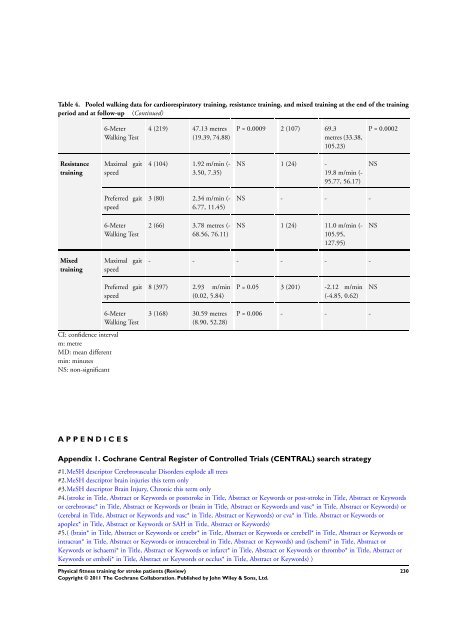Physical fitness training for stroke patients (Review) - Update Software
Physical fitness training for stroke patients (Review) - Update Software
Physical fitness training for stroke patients (Review) - Update Software
Create successful ePaper yourself
Turn your PDF publications into a flip-book with our unique Google optimized e-Paper software.
Table 4. Pooled walking data <strong>for</strong> cardiorespiratory <strong>training</strong>, resistance <strong>training</strong>, and mixed <strong>training</strong> at the end of the <strong>training</strong><br />
period and at follow-up (Continued)<br />
Resistance<br />
<strong>training</strong><br />
Mixed<br />
<strong>training</strong><br />
CI: confidence interval<br />
m: metre<br />
MD: mean different<br />
min: minutes<br />
NS: non-significant<br />
6-Meter<br />
Walking Test<br />
Maximal gait<br />
speed<br />
Preferred gait<br />
speed<br />
6-Meter<br />
Walking Test<br />
Maximal gait<br />
speed<br />
Preferred gait<br />
speed<br />
6-Meter<br />
Walking Test<br />
A P P E N D I C E S<br />
4 (219) 47.13 metres<br />
(19.39, 74.88)<br />
4 (104) 1.92 m/min (-<br />
3.50, 7.35)<br />
3 (80) 2.34 m/min (-<br />
6.77, 11.45)<br />
2 (66) 3.78 metres (-<br />
68.56, 76.11)<br />
P = 0.0009 2 (107) 69.3<br />
metres (33.38,<br />
105.23)<br />
NS 1 (24) -<br />
19.8 m/min (-<br />
95.77, 56.17)<br />
NS - - -<br />
NS 1 (24) 11.0 m/min (-<br />
105.95,<br />
127.95)<br />
- - - - - -<br />
8 (397) 2.93 m/min<br />
(0.02, 5.84)<br />
3 (168) 30.59 metres<br />
(8.90, 52.28)<br />
P = 0.05 3 (201) -2.12 m/min<br />
(-4.85, 0.62)<br />
P = 0.006 - - -<br />
Appendix 1. Cochrane Central Register of Controlled Trials (CENTRAL) search strategy<br />
P = 0.0002<br />
#1.MeSH descriptor Cerebrovascular Disorders explode all trees<br />
#2.MeSH descriptor brain injuries this term only<br />
#3.MeSH descriptor Brain Injury, Chronic this term only<br />
#4.(<strong>stroke</strong> in Title, Abstract or Keywords or post<strong>stroke</strong> in Title, Abstract or Keywords or post-<strong>stroke</strong> in Title, Abstract or Keywords<br />
or cerebrovasc* in Title, Abstract or Keywords or (brain in Title, Abstract or Keywords and vasc* in Title, Abstract or Keywords) or<br />
(cerebral in Title, Abstract or Keywords and vasc* in Title, Abstract or Keywords) or cva* in Title, Abstract or Keywords or<br />
apoplex* in Title, Abstract or Keywords or SAH in Title, Abstract or Keywords)<br />
#5.( (brain* in Title, Abstract or Keywords or cerebr* in Title, Abstract or Keywords or cerebell* in Title, Abstract or Keywords or<br />
intracran* in Title, Abstract or Keywords or intracerebral in Title, Abstract or Keywords) and (ischemi* in Title, Abstract or<br />
Keywords or ischaemi* in Title, Abstract or Keywords or infarct* in Title, Abstract or Keywords or thrombo* in Title, Abstract or<br />
Keywords or emboli* in Title, Abstract or Keywords or occlus* in Title, Abstract or Keywords) )<br />
<strong>Physical</strong> <strong>fitness</strong> <strong>training</strong> <strong>for</strong> <strong>stroke</strong> <strong>patients</strong> (<strong>Review</strong>)<br />
Copyright © 2011 The Cochrane Collaboration. Published by John Wiley & Sons, Ltd.<br />
NS<br />
NS<br />
NS<br />
230












